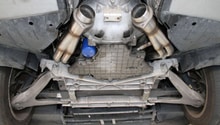Corvette: Why is my Suspension Bouncy?
There are different causes and solutions to a bumpy ride. This guide assesses them one by one.
This article applies to the Chevrolet Corvette C5, C6 and C7 Corvette (1997-current).
If the suspension in your Corvette is not doing its job, you will notice immediately. A bouncy suspension can lead to an uncomfortable ride and can even be dangerous. This problem can have different causes and solutions, so it's best to try one thing at a time until you get a solution that works.

Materials Needed
- Torque wrench
- Socket set
- Tire pressure gauge
- Tire pressure relief valve
Step 1 – Check the shock absorbers
The most likely cause of a bouncy suspension is that the shock absorbers are no longer working properly. You will first want to check for any oil leaks on or around the body of the shock absorber, as this is a clear sign that they need to be replaced. Another way to check is to perform a simple test. Push down on one corner of the car and then release it. If the car bounces more than once, then the shock absorber most likely needs to be replaced.

Pro Tip
If you do have to replace a shock absorber, then you should also replace the one across from it so that the car will ride evenly.
Step 2 – Check the leaf springs
Leaf springs can crack, especially with age. The leaf springs should be repaired or replaced depending on the severity of the damage. However, repairing a leaf spring is something best left to a professional so it may be more cost-effective to replace it.

Step 3 – Check the tire pressure
If your tires are over inflated, they won't absorb as much impact on the road. Use a tire gauge to check the air pressure. If it's above the recommended level, release a bit of tire pressure using a relief valve. Don't go too low or you'll start having performance issues when you drive.

Step 4 – Change out your tires or wheels
Your wheels might be too big or the tire's sidewall height is too short. The size of your wheel affects the height of your tires' sidewalls. Tires with a short sidewall can cause an uncomfortably bumpy ride because there is not enough tire around the wheel to absorb the impact.

Step 5 – Adjust your suspension
You might not have your suspension set up correctly. This is the most difficult thing to troubleshoot because it's easy to mess up. You can purchase an adjustable suspension kit which can cost in excess of $3,000 for a full kit, or you can get the part you'd like to change separately. You can add heavier roll bars if your car is bouncy when going around corners. You can put in softer leaf springs to lessen the impact of going over bumps and hills. You can increase the firmness in your shock absorbers to decrease the rebound. All of these things are variable, so finding the right combination is up to you.

Related Discussions
- Bouncy Suspension - CorvetteForum.com
- Modded Suspension "Bouncy" on the Street - CorvetteForum.com






